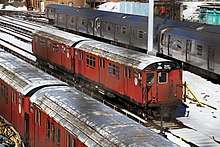R26 (New York City Subway car)
| R26 | |
|---|---|
 R26s 7774 and 7775 at Concourse Yard. | |
| In service | 1959–2002 |
| Manufacturer | American Car and Foundry |
| Constructed | 1959-1960 |
| Entered service | October 12, 1959 |
| Scrapped | 2001–2002 |
| Number built | 110 |
| Number preserved | 2 |
| Number scrapped | 108 |
| Formation | Semi-Married Pairs |
| Fleet numbers | 7750-7859 |
| Capacity | 44 |
| Operator(s) | New York City Subway |
| Specifications | |
| Car body construction | LAHT carbon steel |
| Car length | 51.04 ft (15.56 m) |
| Width | 8.75 ft (2,667 mm) |
| Height | 11.86 ft (3,615 mm) |
| Doors | 6 sets of 50 inch wide side doors per car |
| Maximum speed | 55 mph (89 km/h) |
| Weight |
70,000 lb (32,000 kg) (post-rebuild) |
| Traction system | General Electric 17KG192B1 (7804-7859 formerly Westinghouse) |
| Traction motors | General Electric 1257F1 or Westinghouse 1447J |
| Power output | 115 hp (86 kW) |
| Electric system(s) | 600 V DC Third rail |
| Current collection method | Contact shoe |
| Braking system(s) | WABCO, "SMEE" (electrodynamic) |
| Coupling system | H2C |
| Track gauge | 4 ft 8 1⁄2 in (1,435 mm) standard gauge |
The R26 was a New York City Subway car model built by American Car and Foundry from 1959 to 1960 for the IRT A Division.
Description
The R26s were numbered 7750-7859. They were the first cars to not be built with operating cabs at both ends.
The even-numbered car carried the motor generator and battery set for electrical equipment while the odd numbered car held air compressor for the brakes. A special version of the H2C coupler was used to link the cars so they could easily be split if needed and thus, they were called "semi-permanent pairs." Only the No.1 end had the operator controls. The No.2 end had conductor's controls only. Although referred as the "blind end," these ends did have windows for the conductor.
The R26s were the first cars to use single, sealed storm windows since the R14s, and pink colored-molded hard fiberglass seats. The hard fiberglass seats would become standard seating from this order onward for all new cars purchased to cut down on vandalism, and reduce maintenance costs, etc.
The first set of R26/R28s was placed in service on the 6 train on October 12, 1959. By 1982, all cars in this series have received air conditioning as part of a retrofitting program. Rebuilt by Morrison Knudsen in Hornell, New York between 1985 and 1987, the R26s were repainted as Redbirds and were the first cars to be repainted in the scheme. They re-entered service particularly on the 2 and 5 trains.
Retirement
As time wore on, heavy service took their toll on these cars. The R142 and R142A car orders replaced the entire R26 fleet. The first R26s were retired in May 2001 until the last train with R26s ran on October 7, 2002, with the last pairs of R28s and two pairs of R29s (the latter of which was retired weeks later).[1]
After retirement, many cars were stripped to help create the Redbird Reef. They made their last trip on October 24, 2002 on the 5 service.[1] In 2002, cars 7770-7771 became school cars at Canarsie Yard. This pair was later sent to the Concourse Yard and later to the 207th Street Yard. The pair was finally reefed in September 2009.
Today, cars 7774-7775 are currently the only surviving R26s. This pair was previously stored at the Unionport Yard until July 2013, when they were moved to the Concourse Yard for storage and preservation, along with R28s 7924-7925 and R29s 8678-8679.
Route assignment history
Note: All cars became General Electric (GE) cars and became permanently paired with link bars after rebuilding.[1]
| Service | Years In Service | Cars |
|---|---|---|
| 6 | 1959–1966 | All cars[1] |
| 2,4,5 | 1966–1976 | General Electric (GE) cars[1] |
| 2/5 | 1976–1985 | General Electric (GE) cars[1] |
| 6 | 1966–1985) | Westinghouse (WH) cars[1] |
| 7 | 1978–1985 | some General Electric (GE) and Westinghouse (WH) cars as a temporary replacement for cars being sent out for air conditioning, overhaul and rebuilding[1] |
| 2/5 | (1985–2002) | All cars after overhaul and rebuilding[1] |
See also
- R28 (New York City Subway car) - a very similar model also built by American Car & Foundry Company.